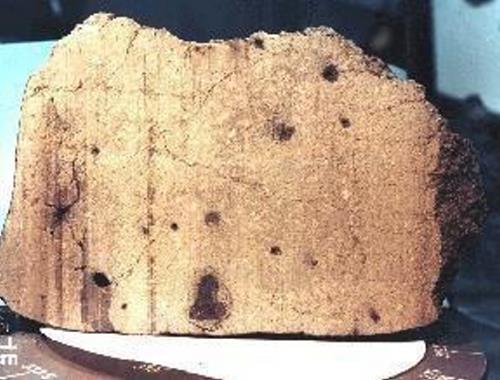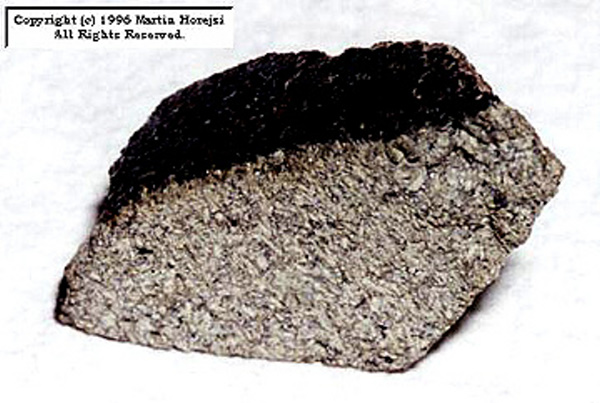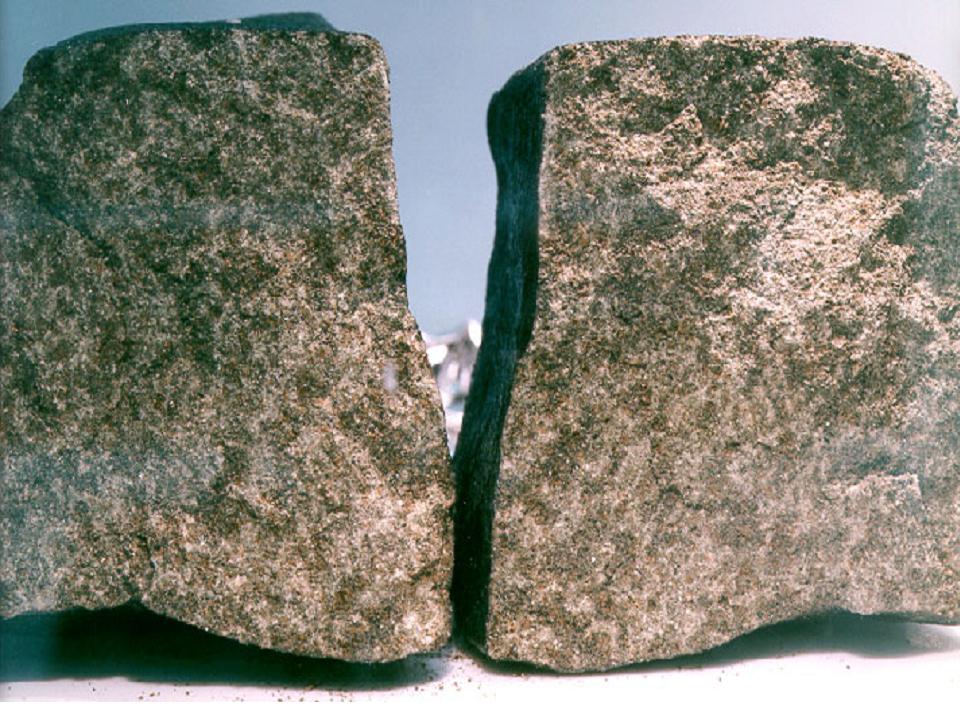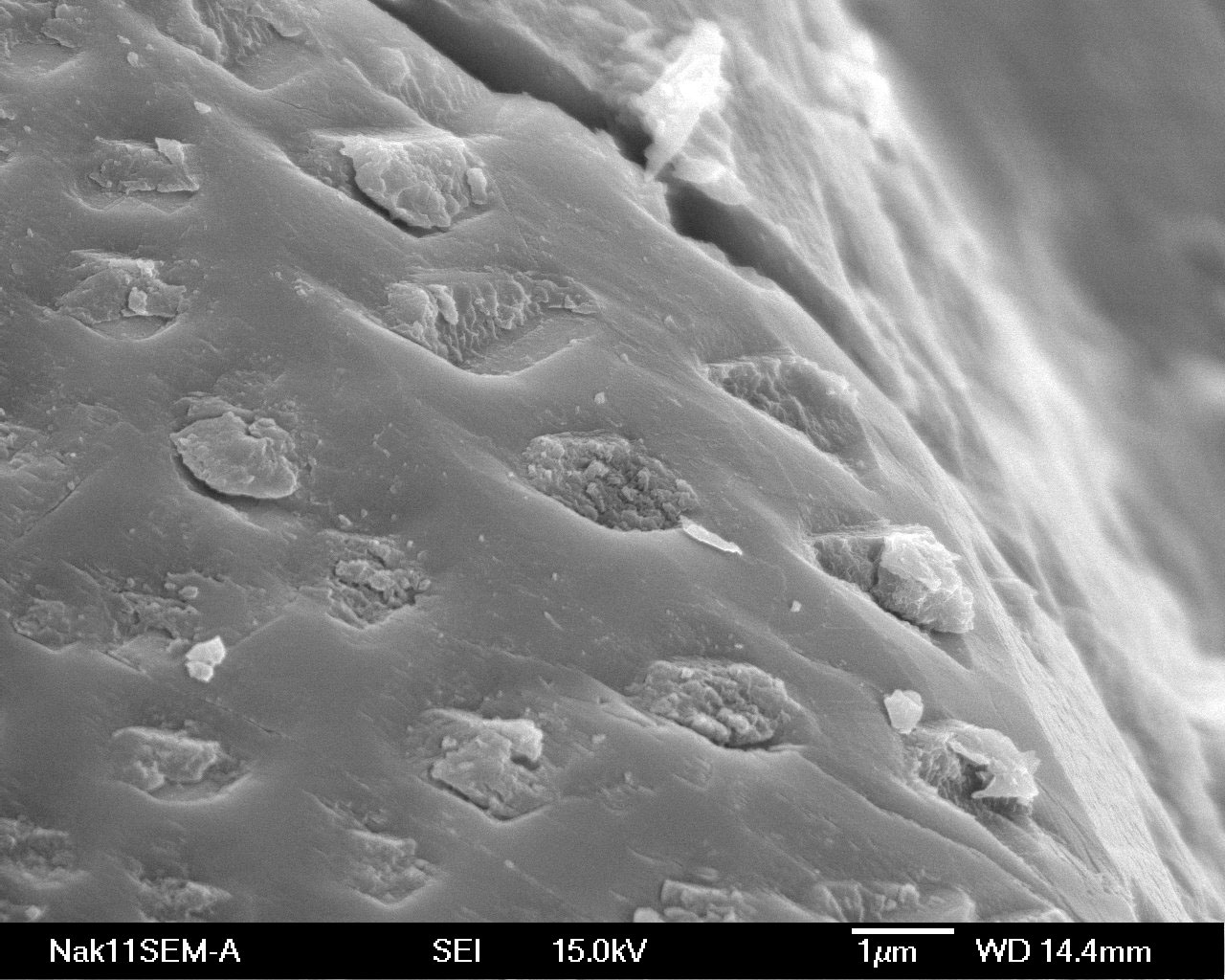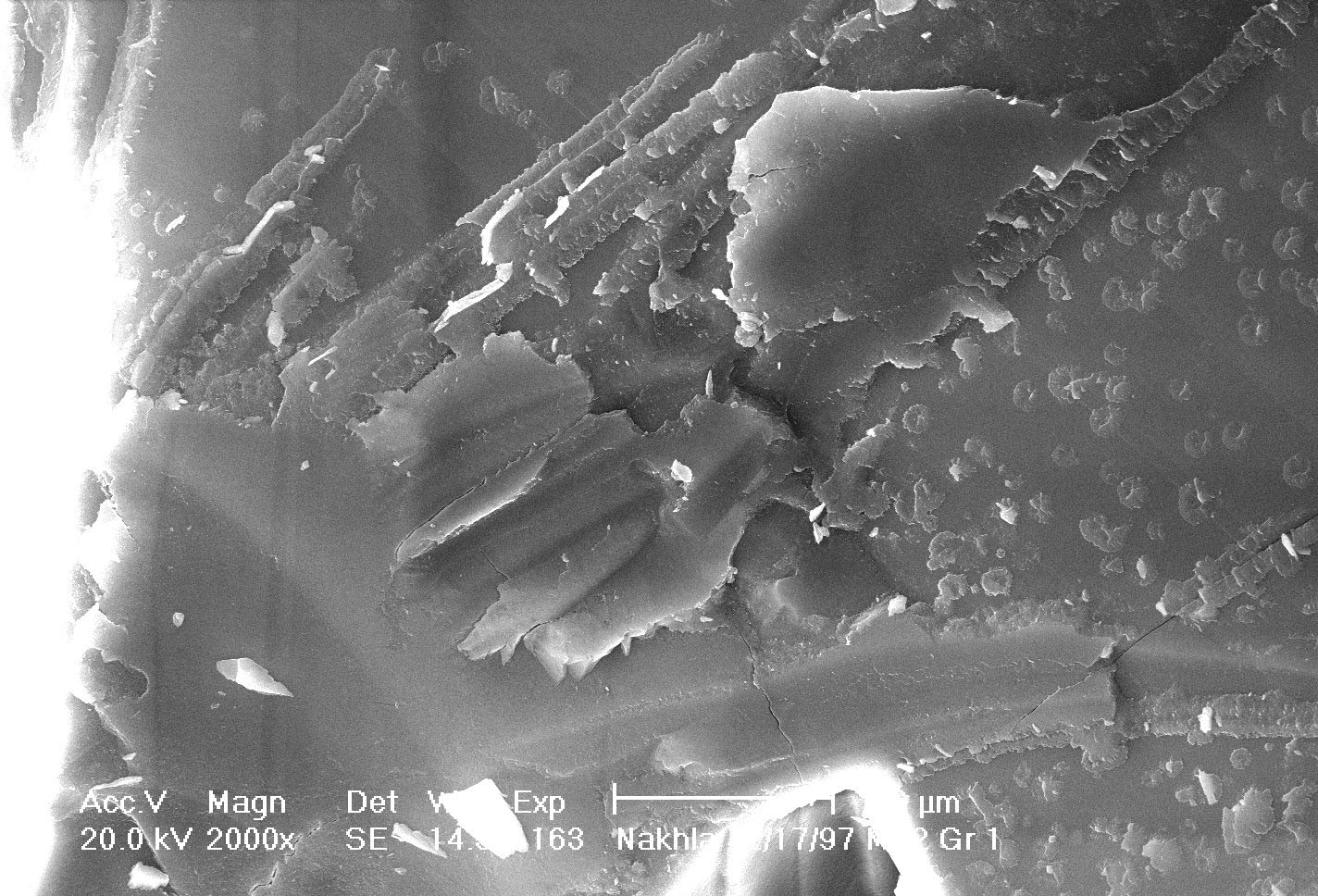Note that this does not refer to meteorites found on Mars, such as Heat Shield Rock
History
In 1983 it was suggested by Smith et al.[3] that meteorites in the so called SNC group (Shergottites, Nakhlites, Chassignites) originated from Mars, from evidence from an instrumental and radiochemical neutron activation analysis of the meteorites. They found that the SNC meteorites possess chemical, isotopic, and petrologic features consistent with data available from Mars at the time, findings further confirmed by Treiman et al.[4] a few years later, by similar methods. Then in late 1983, Bogard et al.[5] showed that the isotopic concentrations of various noble gases of some of the shergottites were consistent with the observations of the atmosphere of Mars made by the Viking spacecraft in the mid-to-late 1970s.
In 2000, an article by Treiman, Gleason and Bogard gave a survey of all the arguments used to conclude the SNC meteorites (of which 14 had been found at the time) were from Mars. They wrote, "There seems little likelihood that the SNCs are not from Mars. If they were from another planetary body, it would have to be substantially identical to Mars as it now is understood."[6]
Composition
33 of the 34 Martian meteorites are divided into three rare groups of achondritic (stony) meteorites: shergottites (24), nakhlites (7), and chassignites (2), with the oddball meteorite ALH 84001 not usually placed in a group.[7] Consequently, Martian meteorites as a whole are sometimes referred to as the SNC group. They have isotope ratios that are said to be consistent with each other and inconsistent with the Earth. The names derive from the location of where the first meteorite of their type was discovered.
Shergottites
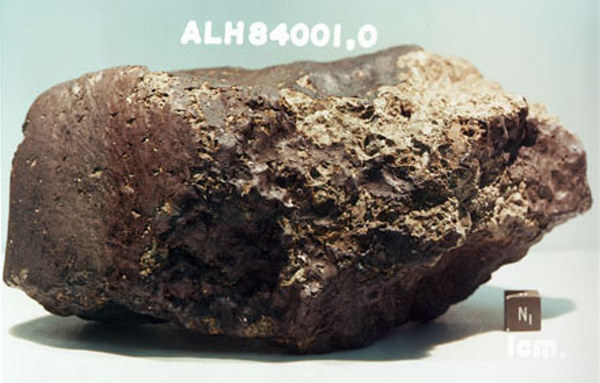 |
Roughly three-quarters of all Martian meteorites can be classified as Shergottites. They are named after the Shergotty meteorite, which fell at Sherghati, India in 1865.[8] Shergottites are igneous rocks of mafic to ultramaficlithology. They fall into three main groups, the Basaltic, Olivine-Phyric and Lherzolitic Shergottites, based on their crystal size and mineral content. They can be categorised alternatively into three or four groups based on their Rare-Earth Element content.[9] These two classification systems do not line up with each other, hinting at complex relationships between the various source rocks and magmas that the Shergottites formed from.
The shergottites appear to have crystallised as recently as 180 million years ago,[10] which is a surprisingly young age considering how ancient the majority of the surface of Mars appears to be, and the small size of Mars itself. Because of this, some have advocated the idea that the Shergottites are much older than this.[11] This "Shergottite Age Paradox" remains unsolved and is still an area of active research and debate.
Nakhlites
 |
There are 7 known nakhlites, the first of which, the Nakhla meteorite, fell in El-Nakhla, Alexandria, Egypt in 1911 and had an estimated weight of 10 kg. The most recent nakhlite was found in Antarctica on December 15, 2003.
Nakhlites are igneous rocks that are rich in augite and were formed from basalticmagma about 1.3 billion years ago. They contain augite and olivinecrystals. Their crystallization ages, compared to a crater count chronology of different regions on Mars, suggest the nakhlites formed on the large volcanic construct of either Tharsis, Elysium, or Syrtis Major.[12]
It has been shown that the nakhlites were suffused with liquid water around 620 million years ago and that they were ejected from Mars around 10.75 million years ago by an asteroid impact. They fell to Earth within the last 10,000 years.[12]
Chassignites
The first chassignite, the Chassigny meteorite, fell at Chassigny, Haute-Marne, France in 1815. There has been only one other chassignite recovered, named Northwest Africa (NWA) 2737. NWA 2737 was found in Morocco or Western Sahara in August 2000 by meteorite hunters Bruno Fectay and Carine Bidaut, who gave it the temporary name "Diderot." It was shown by Beck et al.[13] that its "mineralogy, major and trace element chemistry as well as oxygen isotopes revealed an unambiguous Martian origin and strong affinities with Chassigny."
Other types
The famous specimen ALH 84001 has a different rock type than other martian meteorites: it is an orthopyroxenite (an igneous rock dominantly composed of orthopyroxene). This meteorite received a lot of attention after an electron microscope revealed structures that were considered to be the fossilized remains of bacteria-like lifeforms. As of 2005, scientific consensus was that the microfossils were not indicative of Martian life, but of contamination by earthly biofilms. However, in 2009, new analyses ruled out earthly and non-biological origins, presenting strong evidence of life on Mars.[14] ALH 84001 is as old as the basaltic and intermediate shergottite groups ā i.e., 4.1 billion years old.
In March 2004 it was suggested that the unique Kaidun meteorite, which landed in Yemen on March 12, 1980, may have originated on the Martian moon of Phobos.[15] Because Phobos has similarities to chondritic asteroids and because the Kaidun meteorite is a chondrite, Kaidun is not a Martian meteorite in the strict sense. However, it may contain small fragments of material from the Martian surface.
Origin
The majority of SNC meteorites are quite young by geologic standards and seem to imply that volcanic activity was present on Mars only a few hundred million years ago. Cosmic ray traces in the meteorites indicate relatively short stays (3 to 3.5 million years) in space. It has been asserted that there are no large young craters on Mars that are candidates as sources for the SNC meteorites, but recent research claims to have a likely source for ALH84001[16] and a possible source for other shergottites.[17]
Possible evidence of life
Several Martian meteorites have been found to contain what some think is evidence for fossilized Martian life forms. The most significant of these is a meteorite found in the Allan Hills of Antarctica (ALH84001). Ejection from Mars seems to have taken place about 16 million years ago. Arrival on Earth was about 13 000 years ago. Cracks in the rock appear to have filled with carbonate materials (implying groundwater was present) between 4 and 3.6 billion-years-ago. Evidence of polycyclic aromatic hydrocarbons (PAHs) have been identified with the levels increasing away from the surface. Other Antarctic meteorites do not contain PAHs. Earthly contamination should presumably be highest at the surface. Several minerals in the crack fill are deposited in phases, specifically, iron deposited as magnetite, that are claimed to be typical of biodepositation on Earth. There are also small ovoid and tubular structures that might be nanobacteriafossils in carbonate material in crack fills (investigators McKay, Gibson, Thomas-Keprta, Zare).[18] Micropaleontologist Schopf, who described several important terrestrial bacterial assemblages, examined ALH 84001 and opined that the structures are too small to be Earthly bacteria and don't look especially like lifeforms to him. The size of the objects is consistent with Earthly "nanobacteria", but the existence of nanobacteria itself is controversial.
In August 2002, a NASA team led by Thomas-Keptra published a study indicating that 25% of the magnetite in ALH 84001 occurs as small, uniform-sized crystals in a crystal form that, on Earth, is associated only with biologic activity. The remainder of the material appears to be normal inorganic magnetite. The extraction technique did not permit determination as to whether the possibly biologic magnetic was organized into chains as would be expected.
Many studies disputed the validity of the fossils.[19][20] For example, it was found that most of the organic matter in the meteorite was of terrestrial origin.[22] But, a recent study suggests that magnetite in the meteorite could have been produced by Martian microbes. The study, published in the journal of the Geochemical and Meteoritic Society, used more advanced high resolution electron microscopy than was possible in 1996.[14][22]
References:
- Meteoritical Bulletin Database
- Shuster, David L.; Weiss, Benjamin P. (July 22, 2005). "Martian Surface Paleotemperatures from Thermochronology of Meteorites". Science 309 (5734): 594600. . doi:10.1126/science.1113077. PMID16040703
- Smith, M.R. et al., "Petrogenesis of the SNC (Shergottites, Nakhlites, Chassignites) Meteorites: Implications for Their Origin From a Large Dynamic Planet, Possibly Mars" - (PDF) Proceedings of the fourteenth Lunar and Planetary Science Conference, Part 2, Journal of Geophysical Research, Vol. 89, Supplement, pp. B612-B630, February 15, 1984.
- Treiman et al., "Core formation in the Earth and Shergottite Parent Body (SPB):Chemical evidence from basalts" - (PDF) Geochemica et Cosnochimica Acta Vol. 50, pp. 1071-1091 (1986).
- Bogard, D.D. et al., "Noble gas contents of shergottites and implications for the Martian origin of SNC meteorites" - (PDF) Geochimica et Cosnocimica Acta Vol. 48, pp. 1723-1739 (1984).
- Treiman, A.H.; et al. (October 2000). "The SNC meteorites are from Mars". Planetary and Space Science 48 (12ā14): 1213ā1230. doi:10.1016/S0032-0633(00)00105-7. Bibcode: 2000P&SS...48.1213T
- Mars Meteorites - A complete list of Martian meteorites from NASA's Jet Propulsion Laboratory. URL accessed September 6, 2006.
- Shergotty Meteorite - JPL, NASA
- The SNC meteorites: basaltic igneous processes on Mars, Bridges & Warren 2006
- Ages and geologic histories of Martian meteorites, Nyquist 2001
- Bouvier, A. et al., 2009. Martian meteorite chronology and the evolution of the interior of Mars. Earth and Planetary Science Letters Volume 280, pp. 285-295. "doi:10.1016/j.epsl.2009.01.042"
- Treiman, A.H., "The nakhlite meteorites: Augite-rich igneous rocks from Mars" - (PDF) Chemie der Erde 65, p. 203-270, (2005). URL accessed September 8, 2006.
- Beck, P et al., "The Diderot meteorite: The second chassignite" - (PDF) 36th Annual Lunar and Planetary Science Conference, March 14ā18, 2005, in League City, Texas, abstract no.1326. URL accessed September 8, 2006.
- Ancient Martians were carried to Earth, November 26, 2009, By PAUL SUTHERLAND, Skymania.com, Scientific American
- Zolensky, M. and Ivanov A. (2003). "The Kaidun Microbreccia Meteorite: A Harvest from the Inner and Outer Asteroid Belt". Chemie der Erde/Geochemistry 63: 185ā246. doi:10.1078/0009-2819-00038
- Birthplace of famous Mars meteorite pinpointed - September 16, 2005 New Scientist article. URL accessed September 8, 2006.
- McEwen, A.S. et al. (2005). "The rayed crater Zunil and interpretations of small impact craters on Mars". Icarus176: 351ā381. doi:10.1016/j.icarus.2005.02.009
- McKay, D. et al. 1996. Search for Past Life on Mars: Possible Relic Biogenic Activity in Martian Meteorite AL84001. Science: 273. 924-930.
- Gibbs, W. and C. Powell. In Focus Bugs in the Data? 1996. Scientific American. October. 20-22
- Controversy Continues: Mars Meteorite Clings to Life - Or Does It? By Leonard David - Senior Space Writer, posted: 20 March 2002, Space.com
- Bada, J. et al. 1998. A Search for Endogenous Amino Acids in Martian Meteorite AL84001. Science: 279. 362-365
- Thomas-Keprta, K., S. Clemett, D. McKay, E. Gibson and S. Wentworth 2009. Origin of Magnetite Nanocrystals in Martian Meteorite ALH84001 journal Geochimica et Cosmochimica Acta: 73. 6631-6677.
- Anatomy of A Martian Meteorite Poster and Information Packet
- ALH84001 meteorite
- Colin Pillinger
- Heat Shield Rock -Heat Shield Rock is a basketball-sized iron-nickel meteorite found on Mars by the Mars rover Opportunity in January 2005. The meteorite was formally named Meridiani Planum meteorite by the Meteoritical Society in October, 2005 (meteorites are always named after the place where they were found).
- Life on Mars
- Lodders, K, "A survey of shergottite, nakhlite and chassigny meteorites whole-rock compositions" - (PDF) Meteoritics & Planetary Science 33, A183-A190 (1998). At the time of this article 12 SNC meteorites had been found.
- Mars meteorite articles in Planetary Science Research Discoveries
- Mars Meteorite Home Page (JPL)
- Nakhla meteorite
- New Study Adds to Finding of Ancient Life Signs in Mars Meteorite - NASA - 11.25.09
- On the Question of the Mars Meteorite
- Shergotty meteorite
- Shergotty Meteorite - Wikipedia
- Shergotty Meteorite - JPL, NASA
